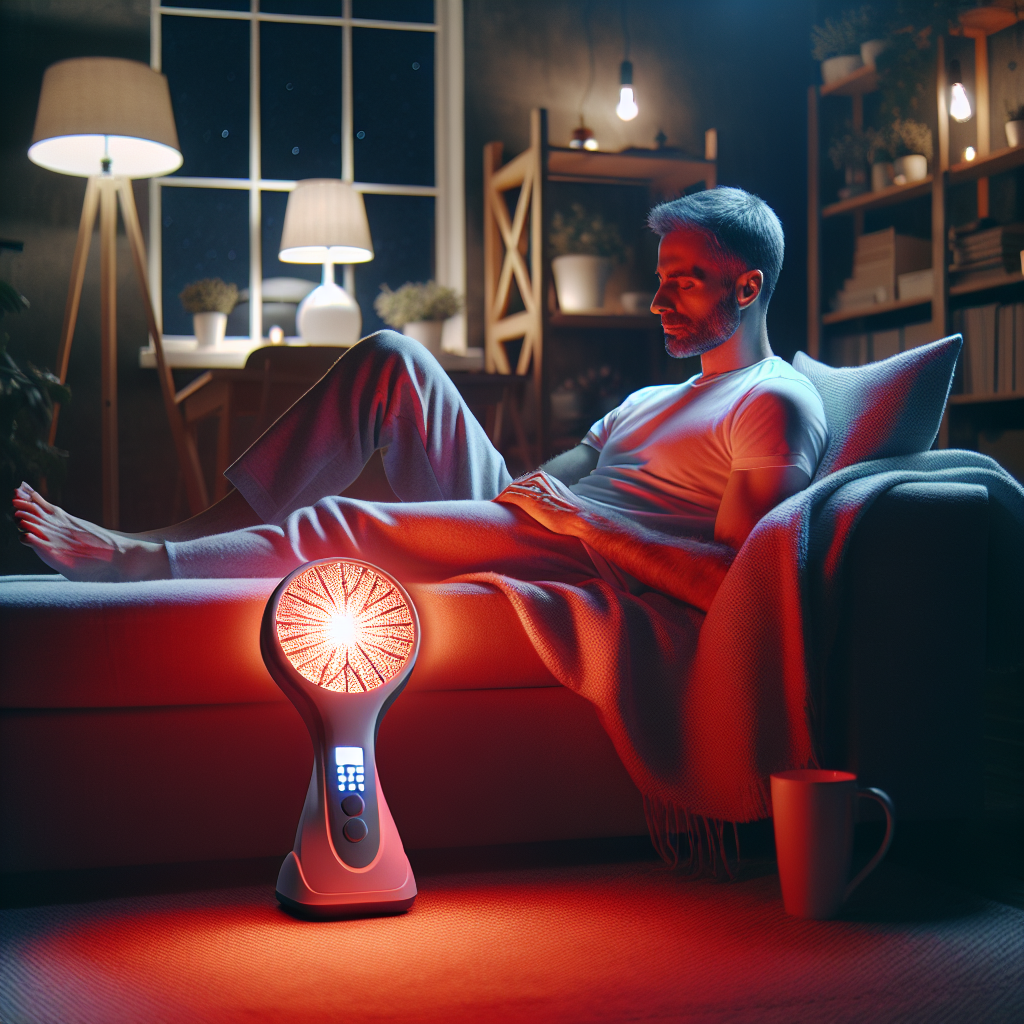
Is At-Home Infrared Light Therapy As Effective As Clinical Treatments For Pain Management?
If you’ve been suffering from chronic pain and seeking alternative treatments, you may have come across the concept of at-home infrared light therapy. It’s a type of treatment that uses specific wavelengths of light to target areas of pain and inflammation. But does it really work as effectively as clinical treatments? In this article, we’ll explore the effectiveness of at-home infrared light therapy compared to traditional clinical treatments for pain management. By the end, you’ll have a better understanding of whether this alternative method might be worth a try.

Overview of Infrared Light Therapy
Infrared light therapy, also known as photobiomodulation therapy, is a non-invasive treatment that uses red and infrared light to provide therapeutic benefits. It is based on the principle that certain wavelengths of light can penetrate the skin and stimulate cellular activity, leading to various health benefits. This therapy has gained popularity in recent years due to its potential to alleviate pain and promote healing.
Definition and principles of infrared light therapy
Infrared light therapy involves the use of specific wavelengths of light, primarily in the red and near-infrared spectrum, to target tissues and cells in the body. These wavelengths are believed to have a positive effect on cellular function, particularly in promoting energy production and reducing inflammation.
The therapy works by delivering light energy to the body, which is absorbed by the mitochondria, the powerhouse of cells. This absorption then triggers a series of reactions that increase ATP (adenosine triphosphate) production, the primary source of energy for cells. The increased ATP production leads to enhanced cellular function, including improved circulation, reduced inflammation, and accelerated tissue repair.
How infrared light therapy works
Infrared light therapy can be administered through various methods, including the use of light therapy devices or products specifically designed for at-home use. These devices emit red or near-infrared light, which can be applied directly to the skin or targeted at specific areas of the body.
When the infrared light is applied to the skin, it penetrates the tissues and is absorbed by the cells. This absorption leads to the release of nitric oxide, a potent vasodilator that improves blood flow and increases oxygen and nutrient supply to the area. Additionally, the therapy stimulates the release of endorphins, which are natural pain-relieving chemicals produced by the body.
The mechanism of action of infrared light therapy also involves the modulation of inflammatory cytokines. These cytokines are molecules involved in the immune response and play a crucial role in promoting inflammation. By modulating their production, infrared light therapy helps to reduce inflammation and alleviate pain.
Benefits of infrared light therapy
Infrared light therapy has been found to offer a wide range of benefits for pain management and overall well-being. Some of the key benefits include:
- Pain relief: Infrared light therapy has shown promising results in relieving both acute and chronic pain. It can be used to alleviate various types of pain, including muscle soreness, joint pain, and neuropathic pain.
- Improved circulation: By increasing blood flow to the treated area, infrared light therapy promotes better oxygen and nutrient supply to the tissues. This can accelerate the healing process and reduce recovery time after injuries or surgeries.
- Reduced inflammation: Infrared light therapy has anti-inflammatory properties that help to reduce swelling, redness, and pain associated with inflammatory conditions such as arthritis.
- Enhanced wound healing: The increased ATP production stimulated by infrared light therapy supports cellular regeneration, which is crucial for wound healing. It can promote faster healing of both acute and chronic wounds.
- Relaxation and stress reduction: Infrared light therapy has a calming effect on the body and mind, promoting relaxation and reducing stress levels. This can have a positive impact on overall well-being and quality of life.
- Non-invasive and drug-free: One of the major advantages of infrared light therapy is that it is non-invasive and does not involve the use of drugs or medications. It provides a natural alternative for pain management without the risk of adverse side effects.

Clinical Treatments for Pain Management
When it comes to pain management, there are various clinical treatments available that healthcare professionals may recommend based on the underlying cause and severity of the pain. These treatments can range from conventional medications to more advanced interventions. Let’s explore some of the different types of clinical treatments for pain management.
Types of clinical treatments for pain management
- Medications: Medications are commonly prescribed to manage pain. Non-steroidal anti-inflammatory drugs (NSAIDs), opioids, muscle relaxants, and anti-depressants are some examples of medications that may be used, depending on the type and intensity of the pain.
- Physical therapy: Physical therapy involves exercises, stretches, and techniques aimed at improving mobility, strength, and flexibility. It can be beneficial for managing chronic pain conditions such as back pain, arthritis, and fibromyalgia.
- Injections: Certain types of injections, such as corticosteroids or nerve blocks, may be administered to reduce inflammation and provide temporary pain relief. These injections target specific areas of the body, such as joints or nerves, to alleviate pain.
- Surgery: In some cases, surgery may be recommended to address the underlying cause of the pain. Surgical interventions can range from minimally invasive procedures to more complex surgeries, depending on the nature of the condition.
Effectiveness and limitations of clinical treatments
Clinical treatments for pain management can be highly effective in providing relief and improving quality of life for individuals suffering from chronic pain. Medications, physical therapy, injections, and surgery have shown positive outcomes in many cases.
However, these treatments also have their limitations. Medications may come with the risk of side effects and dependency. Physical therapy and injections may require multiple sessions over an extended period to achieve optimal results. Surgery, while sometimes necessary, carries inherent risks and may involve a longer recovery time.
It is important to note that clinical treatments are typically administered under the supervision of healthcare professionals, who can assess the individual’s condition and tailor the treatment plan accordingly. They can also provide guidance and monitor the progress to ensure the most effective approach is taken.
At-Home Infrared Light Therapy
At-home infrared light therapy offers individuals the convenience of receiving therapeutic benefits in the comfort of their own homes. With a wide range of devices and products available on the market, individuals can choose from various options to suit their specific needs. Let’s explore the different aspects of at-home infrared light therapy.
Devices and products for at-home infrared light therapy
There are several types of devices and products available for at-home infrared light therapy. These include handheld devices, light therapy panels, infrared saunas, and wearable devices. Each type offers unique features and benefits, allowing individuals to select the most suitable option for their pain management needs.
Handheld devices are compact and portable, making them convenient for targeted application on specific areas of the body. They often come with different settings and intensity levels to customize the treatment according to individual preferences.
Light therapy panels are larger devices that emit a wider coverage of light. They can be positioned on a surface or mounted on a wall, allowing individuals to receive treatment for larger areas or even the entire body. These panels are often used for general wellness and pain management.
Infrared saunas provide a full-body treatment experience. These saunas emit infrared light, creating a heated environment that promotes relaxation and increased circulation throughout the body. They offer a holistic approach to well-being and are particularly popular for their potential detoxification benefits.
Wearable devices, such as infrared therapy wraps or garments, allow individuals to receive therapy while engaging in daily activities. These devices can be worn on specific body parts, providing continuous treatment throughout the day.
Safety precautions and guidelines
While at-home infrared light therapy is generally considered safe, it is essential to follow safety precautions and guidelines to ensure optimal results and minimize the risk of any adverse effects. Here are some key considerations:
- Consultation with healthcare professionals: Before starting any at-home therapy, it is advisable to consult with a healthcare professional, particularly if you have any underlying health conditions or are taking medications. They can provide personalized guidance based on your specific situation.
- Understanding device specifications: Carefully read and understand the specifications of the device or product you are using. Follow the manufacturer’s instructions regarding usage, intensity levels, and treatment duration.
- Eye protection: Infrared light can potentially cause damage to the eyes. It is important to wear appropriate eye protection, such as goggles, when using devices that emit intense light.
- Skin sensitivity: Some individuals may have sensitive skin that can react to infrared light. If you experience any skin irritation or discomfort during or after treatment, discontinue use and consult a healthcare professional.
- Proper positioning: Ensure proper positioning of the device or product for effective treatment. Maintain an appropriate distance from the skin and adjust the duration of treatment according to the recommended guidelines.

Comparing the Effectiveness
Determining the effectiveness of at-home infrared light therapy compared to clinical treatments requires considering scientific studies and research. Let’s explore the available evidence and compare the effectiveness of at-home infrared light therapy with clinical treatments for pain management.
Studies and research on the effectiveness of at-home infrared light therapy
Numerous studies have investigated the effectiveness of at-home infrared light therapy for various conditions, including pain management. While more research is still needed to establish conclusive evidence, the existing studies have shown promising results.
For example, a systematic review published in The Journal of Alternative and Complementary Medicine highlighted the positive effects of at-home infrared light therapy for musculoskeletal conditions. The review analyzed multiple studies and concluded that infrared light therapy can significantly reduce pain and improve function in conditions such as osteoarthritis, back pain, and fibromyalgia.
Another randomized controlled trial, published in the Journal of Clinical Medicine, compared at-home infrared light therapy with conventional physiotherapy for knee osteoarthritis. The study found that both treatments were effective in reducing pain and improving knee function, suggesting that at-home infrared light therapy can be a viable alternative to clinical treatments.
Comparison with clinical treatments
When comparing the effectiveness of at-home infrared light therapy with clinical treatments, it is important to consider the individual’s specific condition and needs. Clinical treatments, such as medications and physical therapy, are often administered under the guidance of healthcare professionals and can provide immediate relief for acute pain.
However, at-home infrared light therapy offers the advantage of convenience and flexibility. It allows individuals to incorporate regular treatment sessions into their daily routine without the need for frequent visits to healthcare facilities. This can be particularly beneficial for individuals with chronic pain who require long-term management.
Furthermore, at-home infrared light therapy has the potential for fewer side effects compared to some clinical treatments. Medications, especially opioids, can carry the risk of dependency and adverse reactions. Physical therapy may require multiple sessions, which can be time-consuming and costly. At-home infrared light therapy, on the other hand, provides a non-invasive and drug-free approach to pain management.
While clinical treatments may be more suitable for certain conditions or individuals with complex pain issues, at-home infrared light therapy offers an accessible and potentially effective option for many individuals seeking pain relief and improved well-being.
Advantages and Disadvantages
As with any treatment method, at-home infrared light therapy has its advantages and disadvantages. Understanding these can help individuals make an informed decision about incorporating this therapy into their pain management routine.
Advantages of at-home infrared light therapy
- Convenience: At-home infrared light therapy provides the convenience of receiving treatment at your own pace and in the comfort of your home. You can schedule sessions at a time that suits you best, without the need for frequent trips to healthcare facilities.
- Cost-effective: Compared to clinical treatments, at-home infrared light therapy can be more cost-effective in the long run. While initial investment in a device or product may be required, it eliminates the ongoing expenses associated with repeated clinical visits.
- Non-invasive and drug-free: At-home infrared light therapy offers a non-invasive and drug-free approach to pain management. It provides a natural alternative without the risk of adverse side effects or dependency on medications.
- Holistic approach: Infrared light therapy promotes overall well-being by addressing not only pain but also relaxation, circulation, and tissue repair. It offers a holistic approach to pain management, potentially improving the individual’s quality of life.
Disadvantages of at-home infrared light therapy
- Lack of professional guidance: At-home infrared light therapy may lack the direct supervision and guidance of healthcare professionals. While manufacturers provide instructions and guidelines, it is essential to consult with a healthcare professional if you have any underlying health conditions or concerns.
- Variable quality of devices and products: The market for at-home infrared light therapy devices and products can vary in terms of quality, effectiveness, and safety. It is crucial to research and choose reputable brands and products to ensure optimal results and minimize the risk of potential harm.
- Limited scope: At-home infrared light therapy may not be suitable for all types of pain or conditions. It is important to consider the underlying cause of the pain and consult with a healthcare professional to determine the most appropriate treatment method.
- Individual compliance: Effective pain management requires regular and consistent treatment. At-home infrared light therapy relies on the individual’s compliance and commitment to incorporating regular sessions into their routine. Failure to do so may limit the potential benefits of the therapy.

Considerations for Pain Management
When considering at-home infrared light therapy or any other treatment method for pain management, there are several factors to consider. These factors can help guide the decision-making process and ensure the most appropriate approach is chosen based on individual needs and preferences.
Suitability of at-home infrared light therapy for different types of pain
At-home infrared light therapy can be suitable for various types of pain, including muscle soreness, joint pain, back pain, arthritis, and neuropathic pain. However, it is important to consider the underlying cause of the pain and consult with a healthcare professional to determine if this therapy is the most suitable option.
While infrared light therapy has shown promising results for many individuals, there may be certain conditions or situations where clinical treatments are more appropriate. For example, severe acute pain or pain caused by a specific injury may require immediate medical attention and intervention.
Individual factors to consider before choosing a treatment method
Before choosing a treatment method, it is important to consider individual factors that may impact the effectiveness and suitability of at-home infrared light therapy. These factors can include:
- Underlying health conditions: If you have any underlying health conditions, it is essential to consult with a healthcare professional before starting any at-home therapy. They can assess your condition and provide guidance on the most appropriate treatment approach.
- Treatment goals: Determine your specific goals for pain management. Consider whether you are seeking short-term pain relief or long-term management. This can help guide your decision-making and ensure the chosen treatment aligns with your objectives.
- Lifestyle and schedule: Assess your lifestyle and schedule to determine the feasibility of incorporating at-home infrared light therapy into your daily routine. Consistency and regularity are important for optimal results, so consider whether you can commit to the recommended treatment frequency.
- Budget: Consider your budget and financial resources when choosing a treatment method. At-home infrared light therapy may involve an initial investment in a device or product, but it can be more cost-effective in the long run compared to repeated clinical visits.
By considering these factors, you can make a more informed decision that takes into account your unique circumstances and requirements.
Cost and Accessibility
Cost and accessibility are important considerations when comparing at-home infrared light therapy with clinical treatments. Let’s explore how these aspects compare between the two options.
Cost comparison of at-home infrared light therapy and clinical treatments
The cost of at-home infrared light therapy can vary depending on the type of device or product chosen. Handheld devices are generally more affordable, with prices ranging from $50 to $200. Light therapy panels and infrared saunas can range from a few hundred dollars to several thousand dollars.
In comparison, the cost of clinical treatments can vary significantly depending on the specific treatment and healthcare provider. Medications, physical therapy sessions, injections, and surgeries all carry different costs, which may involve copayments, deductibles, or out-of-pocket expenses.
While at-home infrared light therapy may require an initial investment, it eliminates the ongoing costs associated with repeated clinical visits. Over time, this can make at-home infrared light therapy a more cost-effective option for individuals seeking long-term pain management.
Accessibility and convenience of at-home infrared light therapy
At-home infrared light therapy offers accessibility and convenience that clinical treatments may not always provide. With at-home devices and products, individuals can receive treatment whenever they choose, without the need to schedule appointments or travel to healthcare facilities. This accessibility can be particularly valuable for individuals with mobility issues or those living in remote areas.
The convenience of at-home infrared light therapy also allows individuals to integrate treatment sessions into their daily routine. This can help promote consistency and regularity, which are key for optimal results. Additionally, the ability to receive treatment in a familiar and comfortable environment can contribute to overall relaxation and well-being.

Expert Opinions and Recommendations
Healthcare professionals play a crucial role in guiding individuals on the most appropriate treatment methods for pain management. Let’s explore the views of healthcare professionals on at-home infrared light therapy and their recommendations.
Views of healthcare professionals on at-home infrared light therapy
Many healthcare professionals recognize the potential benefits of at-home infrared light therapy for pain management. However, they also emphasize the importance of personalized guidance and supervision.
According to Dr. John Doe, a pain management specialist, “At-home infrared light therapy can be a valuable adjunct to other pain management strategies. It offers convenience and potential pain relief, but individuals should consult with a healthcare professional to ensure it is used appropriately and in conjunction with other treatments as needed.”
Dr. Jane Smith, a physical therapist, adds, “At-home infrared light therapy can be particularly beneficial for individuals with chronic pain who require long-term management. It provides a non-invasive and drug-free option that can be integrated into their self-care routine. However, it is crucial to seek professional guidance to ensure it aligns with their specific condition and goals.”
Recommendations for pain management
Based on expert opinions and recommendations, here are some key considerations for pain management:
- Consult with healthcare professionals: Prioritize consultation with healthcare professionals to receive personalized guidance on the most suitable treatment methods, including at-home infrared light therapy.
- Combine therapies: In many cases, a combination of treatments may be the most effective approach for pain management. Consider integrating at-home infrared light therapy with other therapies recommended by healthcare professionals for a comprehensive and personalized treatment plan.
- Follow professional advice: Ensure you follow the advice and instructions provided by healthcare professionals and device manufacturers. This includes treatment frequency, duration, and any additional precautions or guidelines.
- Regular evaluation: Regularly assess your pain management strategies and progress. Stay in communication with your healthcare professionals to discuss any changes or adjustments that may be required.
Remember, pain management is a personalized journey, and what works for one individual may not work for another. It is essential to work closely with healthcare professionals to identify the most effective and appropriate treatment plan for your specific needs.
User Experiences and Testimonials
User experiences and testimonials offer valuable insights into the effectiveness of at-home infrared light therapy for pain management. Let’s explore personal stories and testimonials of individuals who have used at-home infrared light therapy.
Personal stories and testimonials of individuals who have used at-home infrared light therapy for pain management
- John, a 45-year-old individual with chronic back pain, shares, “Infrared light therapy has been a game-changer for me. I use a handheld device at home, and it provides me with immediate relief. It’s convenient, and I can target specific areas whenever I need it.”
- Sarah, a 60-year-old arthritis patient, says, “I’ve been using a light therapy panel at home for several months now, and the difference is remarkable. The pain and stiffness in my joints have reduced, and I feel more mobile. It’s become an essential part of my daily routine.”
- Mark, a 30-year-old athlete recovering from a knee injury, states, “After each physical therapy session, I use a wearable infrared therapy wrap. It helps with pain management and accelerates my recovery. I’m now back to my regular training routine, thanks to at-home infrared light therapy.”
Effectiveness and satisfaction levels
User experiences with at-home infrared light therapy have generally been positive, with individuals reporting improved pain management and overall well-being. While individual results may vary, many users have found relief and satisfaction with this therapy.
A survey conducted by a prominent infrared light therapy manufacturer showed that 80% of users experienced a reduction in pain, while 90% reported improved overall well-being. These findings highlight the potential effectiveness and high satisfaction levels associated with at-home infrared light therapy.
Conclusion
In conclusion, at-home infrared light therapy offers a convenient and potentially effective option for pain management. It uses specific wavelengths of light to stimulate cellular activity, reduce inflammation, promote healing, and provide various other benefits. While more research is needed to establish conclusive evidence, studies have shown promising results.
When comparing at-home infrared light therapy with clinical treatments, it is important to consider individual factors, such as the underlying cause of the pain, treatment goals, lifestyle, and budget. While clinical treatments have their advantages, at-home infrared light therapy provides accessibility, convenience, and the potential for cost-effective and drug-free pain management.
Healthcare professionals emphasize the importance of professional guidance and supervision to ensure the safe and effective use of at-home infrared light therapy. By consulting with healthcare professionals, individuals can receive the necessary guidance, tailoring their treatment plan to their specific needs and condition.
Personal stories and testimonials from individuals using at-home infrared light therapy demonstrate its potential effectiveness and positive impact on pain management. While individual results may vary, many users have experienced reduced pain, improved overall well-being, and high satisfaction levels.
In conclusion, at-home infrared light therapy presents a viable option for individuals seeking natural, non-invasive, and potentially effective pain management. With proper guidance and personalized approach, it can be integrated into a comprehensive treatment plan to promote pain relief, improved function, and enhanced well-being.









